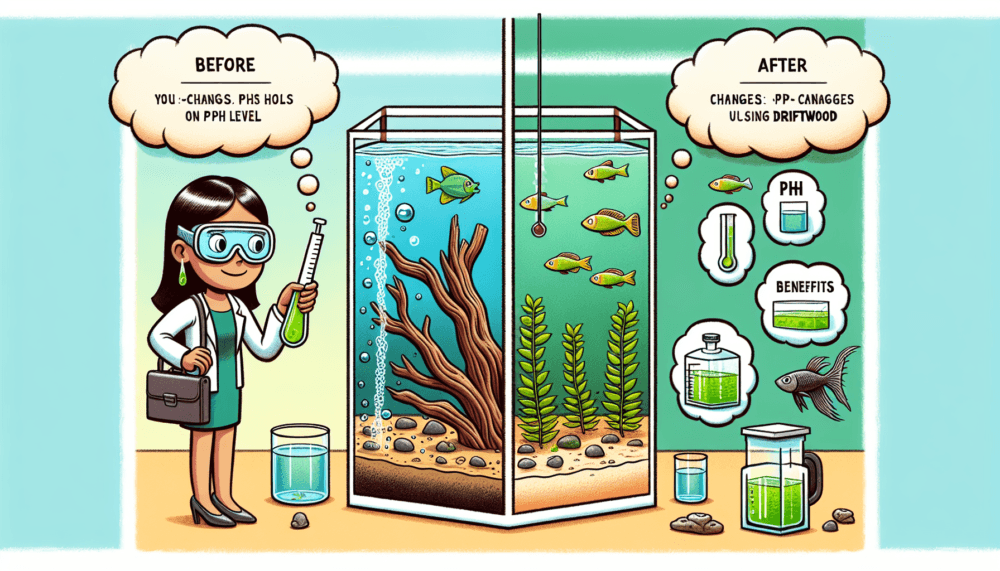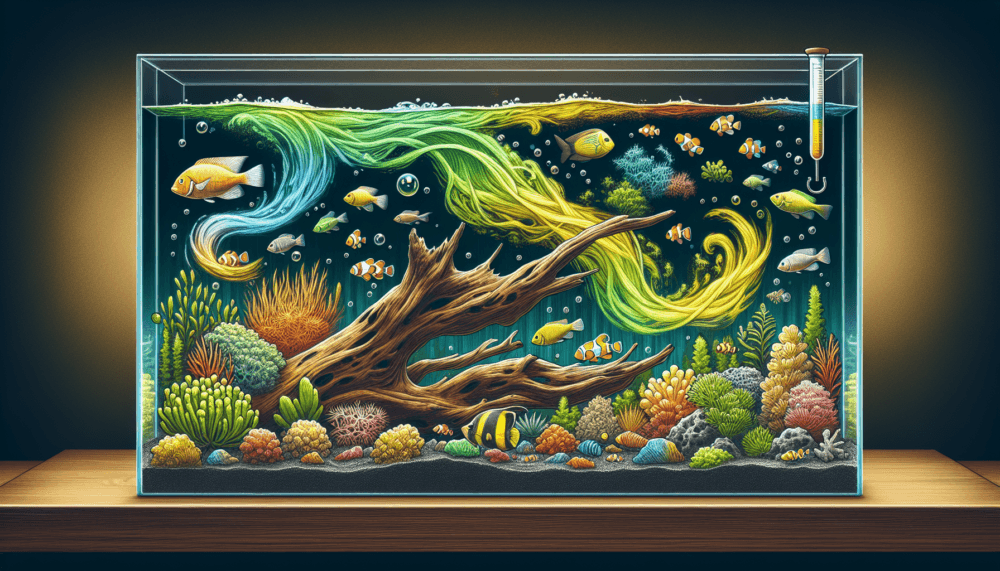Imagine this scenario: you’ve just set up a beautiful aquarium, complete with vibrant fish and luscious plants. Everything seems perfect until you notice that the water’s pH level is off balance. Before you start panicking, have you considered the impact of driftwood on the pH of your aquarium? In this article, we’ll explore the fascinating question of whether driftwood can actually reduce pH levels. Prepare to dive into the world of aquarium phenomena and uncover the truth behind this common belief.

I. What is driftwood?
A. Definition
Driftwood is a term used to describe pieces of wood that have been washed ashore or have fallen into bodies of water such as rivers, lakes, or oceans. These logs, branches, or roots are naturally weathered and leached of their sap, making them suitable for use in aquariums without causing harm to aquatic species.
B. Characteristics
Driftwood exhibits unique characteristics that make it an attractive addition to aquariums. Its natural wood texture, intricate shapes, and varying sizes can create a visually appealing and natural environment for fish and other aquatic organisms. Driftwood may come in various types, including hardwoods like oak or softwoods like pine. Each type has its own distinct appearance and properties, providing aquarists with a range of options to choose from based on their preferences and the needs of their aquatic inhabitants.
II. pH and water chemistry
A. Definition of pH
pH is a measure of the acidity or alkalinity of a solution, indicating the concentration of hydrogen ions present. The pH scale ranges from 0 to 14, with 7 being considered neutral. A pH below 7 is acidic, while a pH above 7 is alkaline.
B. Importance of pH in aquariums
Maintaining the appropriate pH level in an aquarium is vital for the health and well-being of aquatic species. Different species of fish, invertebrates, and plants have specific pH preferences that are essential for their survival and optimal functioning. Fluctuations in pH levels can cause stress, chemical imbalances, and overall distress to the inhabitants of the aquarium, leading to potential health issues or even fatalities.
C. Factors influencing pH
Several factors can influence the pH levels in an aquarium, including water source, substrate, decor, biological processes, and the presence of certain substances. It is important to consider these factors and monitor the pH regularly to ensure a stable and suitable environment for the aquatic species.
D. Ideal pH for different aquatic species
The ideal pH range varies among different species of fish and other aquatic organisms. Some species prefer slightly acidic conditions (pH below 7), such as many South American tetras and catfish, while others thrive in alkaline conditions (pH above 7), like African cichlids. It is important to research the specific pH preferences of the species you intend to keep in your aquarium and provide an environment that meets their requirements.
III. The role of driftwood in aquariums
A. Driftwood as a natural decor
Driftwood serves as a natural decor element in aquariums, simulating the appearance of a natural habitat for aquatic species. Its unique shapes and textures create a visually appealing, visually interesting, and stimulating environment for both the aquarist and the aquatic inhabitants. The addition of driftwood can transform a plain, artificial-looking aquarium into a more natural and aesthetically pleasing setup.
B. Benefits of using driftwood in aquariums
Apart from its decorative role, driftwood offers numerous benefits to aquariums and their inhabitants. One significant advantage is that driftwood provides shelter and hiding places for fish, invertebrates, and other aquatic organisms. This can help reduce stress and create a sense of security, promoting natural behavior and overall well-being. Additionally, driftwood can serve as a substrate for the growth of beneficial bacteria, which help in maintaining a healthy nitrogen cycle within the aquarium.
C. Tannins released by driftwood
Driftwood contains a substance called tannins, which are natural organic compounds. When submerged in water, the tannins are slowly released, resulting in a slight yellow or brown discoloration of the water. This discoloration is often considered desirable by aquarists as it mimics the natural habitats of many species, particularly those native to blackwater environments. Tannins also impart a natural acidic quality to the water, which can affect the pH of the aquarium.
IV. The effect of driftwood on pH
A. Acidic properties of driftwood
Driftwood typically has an acidic nature, primarily due to the presence of tannins. As tannins are released into the water, they contribute to the overall acidity of the aquarium, potentially lowering the pH level. This acidic nature of driftwood can be beneficial for certain species that prefer slightly acidic conditions. However, it is important to monitor the pH to ensure it remains within the desired range for the chosen aquatic inhabitants.
B. Release of organic acids
In addition to tannins, driftwood may also release organic acids into the water. These organic acids include humic and fulvic acids, which contribute to the decomposition process of the wood. The release of these acids can further lower the pH of the aquarium, potentially impacting the overall water chemistry and the well-being of the aquatic species.
C. Impact on pH levels
The release of tannins and organic acids from driftwood can have a noticeable impact on the pH levels of an aquarium. However, the extent of this impact may vary depending on factors such as the water volume, the size of the driftwood, and the initial pH level of the water. Regular monitoring of the pH is essential to ensure that it remains within the desired range and to take appropriate actions if any adjustments are necessary.

V. Measuring pH in a driftwood aquarium
A. Importance of pH testing
Regularly measuring the pH in a driftwood aquarium is crucial to monitor and maintain the appropriate acidity or alkalinity levels for the inhabitants. By knowing the pH level, aquarists can make informed decisions regarding the adjustment of water conditions and ensure a suitable environment for the chosen aquatic species.
B. Methods to measure pH
There are several methods available to measure pH in an aquarium. One commonly used method is to utilize pH testing kits or test strips, which provide accurate and reliable results. These kits typically involve dipping a test strip or adding a few drops of a testing solution into a water sample from the aquarium. The color change observed is then compared to a chart to determine the pH level.
C. Monitoring pH levels in a driftwood aquarium
Regularly monitoring the pH levels in a driftwood aquarium is essential, especially during the initial setup and introduction of driftwood. Initially, the pH might experience a noticeable drop due to the release of tannins and organic acids. However, over time, the pH may stabilize as the driftwood reaches its saturation point and releases fewer tannins. It is recommended to monitor the pH levels at least once a week, or more frequently if necessary, to ensure the stability and suitability of the aquarium environment.
VI. Adjusting pH in a driftwood aquarium
A. Understanding pH adjustment
If the pH level in a driftwood aquarium is not within the desired range for the chosen aquatic species, adjustments may be required. It is important to understand the correct methods of pH adjustment to ensure the well-being of the aquarium inhabitants.
B. Methods to increase pH
To increase the pH in a driftwood aquarium, various methods can be employed. One common method is to use a pH increaser or buffer, which can raise the acidity of the water gradually. Another approach is to incorporate materials such as crushed coral or limestone into the aquarium, as these can naturally raise the pH levels. It is crucial to make gradual adjustments to prevent sudden pH swings, which can stress the aquatic species.
C. Methods to decrease pH
If the pH level is too high in a driftwood aquarium, methods to lower it can be implemented. One effective way is to perform regular water changes using water that has a lower pH. Another option is to incorporate natural substances like peat moss or almond leaves into the aquarium. These substances release tannins and organic acids that can help lower the pH gradually. It is important to note that sudden pH fluctuations can be detrimental to the health of the aquarium inhabitants, so any adjustments should be made gradually and with caution.
VII. Considerations when using driftwood
A. Compatibility with aquarium inhabitants
When using driftwood in an aquarium, it is essential to consider the compatibility of the wood with the chosen aquatic species. Some fish or invertebrates may have sensitivities or adverse reactions to certain types of wood, so thorough research and consideration should be given to ensure the safety and well-being of the aquarium inhabitants.
B. Preparing driftwood for aquarium use
Before adding driftwood to an aquarium, it is crucial to prepare it properly to remove any potential contaminants or impurities. One common method is to soak the driftwood in water for a period of time, often several weeks, to leach out excess tannins and reduce the potential impact on the pH levels. Boiling or scrubbing the driftwood can also aid in the removal of any debris or unwanted substances. Proper preparation ensures that the driftwood is safe and ready for aquarium use.
C. Maintenance and care of driftwood
Driftwood, like any other aquarium decor, requires regular maintenance and care to ensure its longevity and functionality. Periodically inspecting the driftwood for any signs of decay, mold, or damage is important to address any issues promptly. If necessary, driftwood can be cleaned by gently scrubbing it with a soft brush and rinsing it thoroughly. Additionally, as tannins may continue to be released over time, regular water changes and maintenance can help mitigate any potential impact on the pH levels.
VIII. Conclusion
Driftwood can be a valuable and aesthetically pleasing addition to aquariums, providing a natural decor element and numerous benefits for the aquatic inhabitants. Its release of tannins and organic acids can impact the pH levels, maintaining a slightly acidic environment that may be preferred by certain species. However, it is important to monitor and adjust the pH as needed to ensure the well-being of the aquatic species. By understanding the characteristics and effects of driftwood, as well as implementing proper maintenance and care, aquarists can create a beautiful and thriving driftwood aquarium that offers a visually appealing and natural habitat for their aquatic friends.